Sedimentary rocks like limestones, sandstones, flagstones (some), shale, bluestones (some), etc., have many uses at home. These uses are dimensional stones, aggregate, fill, landscaping, and pavers. However, not everyone knows what these rock types are or examples.
This discussion on types of sedimentary rocks and examples will work as a good foundation. Otherwise, things may sound a little complicated.

Contents
- What are sedimentary rocks?
- The three types of sedimentary rocks
- 1. Detrital or clastic sedimentary rocks
- 2. Organic or biological sedimentary rocks
- 3. Chemical sedimentary rock
- 30 Examples of sedimentary rocks
- 1. Sandstone
- 2. Flagstone
- 3. Arkose or Feldspathic arenite
- 4. Graywacke or Wacke
- 5. Arenite
- 5. Breccia
- 6. Conglomerates
- 7. Chert
- 8. Flint
- 9. Coal
- 10. Porcellanite or porcelanite
- 11. Phosphorite (phosphate rock)
- 12. Caliche
- 13. Mudrocks or lutites
- 14. Claystone
- 15. Mudstone (calcilutite)
- 16. Siltstones (aleurolite or calcisiltite)
- 17. Shale
- 18. Oil shale
- 19. Diamictite
- 20. Limestone
- 21. Chalk
- 22. Coquina
- 23. Travertine
- 24. Tufa rock
- 25. Dolostone (dolomite) rock
- 26. Gypsum rock
- 27. Bauxite
- 28. Ironstones or iron formations
- 29. Banded iron formation (BIFs)
- 30. Halite
- Sedimentary rocks by grain size
- Sedimentary rocks by the composition
What are sedimentary rocks?
Sedimentary rocks are rock types that form near or on the earth’s surface from sediments, i.e., pre-existing rock fragments, minerals, or remains of living organisms (plants and animals). The other two rock types are metamorphic and igneous.
The process of formation of sedimentary rocks takes millions of years, and it involves the following basic steps:
- Erosion and weathering – Erosion and weathering occur by the action of wind, ice, water, freezing or thawing, plants, human and animal activities, etc., to form sediments. These sediments include boulders, gravel, sand, clay, silt, ions, plant, or animal remains.
- Transportation- Flowing water, waves, wind, and glaciers, will transport the sediments and dissolved minerals (ions). Some sediment sorting and rounding occur during this movement (from abrasion).
- Deposition: This is the laying of the transported sediments in layers on various sedimentary environments like streams, lakes, deltas, dunes, alluvial fans, glacial, beaches, and shallow or deep marine. During the process, some sorting may occur depending on the energy of the transporting medium.
- Lithification: Lithification involves compaction, cementation, and recrystallization. It transforms sediments into sedimentary rocks. Sometimes, this process is known as Diagenesis.
The three types of sedimentary rocks
There are three main types of sedimentary rocks: clastic, chemical, and organic (biological) sedimentary rocks.
Here is what each of these type means:
1. Detrital or clastic sedimentary rocks
Detrital or clastic sedimentary rocks are made from pre-existing rock clasts or pieces like pebbles, gravel, sand, silt, or clay.
They form when physical weathering and erosion break down larger rocks into smaller fragments or sediments. These smaller fragments are transported and deposited on basins or some hollow or depression. Afterward, they will undergo lithification to form rocks.
Examples of clastic sedimentary rocks are shale, sandstones, conglomerates, mudstones, siltstones, breccia, etc. We will see more examples later.
2. Organic or biological sedimentary rocks
Biological, organic, or biochemical sedimentary rocks form from plant and animal remains, i.e., living organisms. When plants or animals die, their remains may accumulate to form a sedimentary rock.
Biological sedimentary rocks include coal from the carbon-rich plant material and limestone or coquina from marine organisms like oysters, clams, coral, or mussel shells and bones.
However, not all limestones are biological. Some form chemically by precipitation of calcite, aragonite, or water high in calcium. If you are a newbie, calcite is a ubiquitous (found everywhere) rock-forming mineral composed primarily of calcium carbonate.
3. Chemical sedimentary rock
Chemical sedimentary rocks form when minerals dissolved in water precipitate. The precipitation occurs inorganically by evaporation to form evaporate deposits or via a change of temperature and or acidity.
The most common chemical sedimentary rock is limestones. Others are chert, dolomite, iron ore, rock salt, and flint.
30 Examples of sedimentary rocks
You know the three main classifications of sedimentary rock, i.e., clastic, chemical, and organic or biological. It is time to look at some examples, which include the following:
1. Sandstone
Sandstone is a common clastic sedimentary rock with sand-size (1/16 to 2 mm) silicate grains cemented in clay, silica, calcite, or iron oxide. They account for 10-20% of sedimentary rocks, making them the most common after shale.
You can further classify sandstone to grain size. In this category, you will have a fine sandstone as those with grain size 1/16-⅕mm, medium (⅕-3/5mm), and coarse ⅗-2mm.
Also, various types are classified mainly according to the cementing matrix of clastic composition. We will talk about the few popular ones next.
Sandstone color depends on the color of the cementing or clastic fragments. These stones may be gray, blue, tan, brown, yellow, pink, black, white, red, and other colors.

Lastly, soft sandstones have no use. However, hard ones may be dimensional stones for paving (patio, pathways, driveways, pool decks, etc.). Also, you can use them to build (walls, houses, exterior cladding, etc.) or land landscaping. More uses are aggregate or fill, making abrasive, computer chips, glass, fiberglass, paints, etc.
2. Flagstone
Flagstone is a generic name for stones which has been split along bedding layers. So, this is not a geological term that refers to a certain rock but bedded ones.
In most instances, flagstones are sedimentary rocks, especially sandstone, limestone, travertine, and bluestones. But it can mean metamorphic rocks that show fissility (splitting into layers) like slate or quartzite. Even basalt (a volcanic rock) can be a flagstone.
What colors do they are they? Flagstones can be black, gray, red, blue, buff, tan, yellow, etc. The exact color depends on constituent rocks and impurities.

What are their uses? Flagstones are common paving stones for patios, walkways, driveways, pool decks, etc., and stepping stones. Also, you can use them as headstones, façades, retaining walls, or for edging. More uses are curbing, flooring, and roofing, among other constructions.
3. Arkose or Feldspathic arenite
Arkose is a sandstone variety with at least 25% feldspar and quartz as the predominant rock-forming minerals. However, it may have mica, a small amount of calcite cement, and rarely silica or iron oxide. And, sometimes, geologists informally call feldspathic arenite
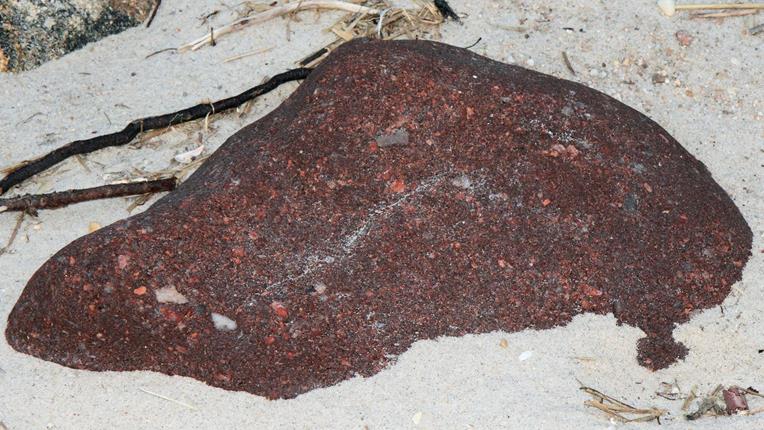
What is its color? Arkose rock is usually reddish to gray but may be pinkish. Its grains are fine to coarse, with most stones tending towards a coarse grain. Also, it is worthwhile mentioning that arkosic sand refers to feldspar-rich sand.
4. Graywacke or Wacke
Graywacke, greywacke, or wacke is a hard, dark-colored, poorly sorted sandstone variety with angular quartz feldspar and other smaller rock fragments cemented in clay or a muddy matrix.
The matrix accounts for at least 15% of the composition, while larger grains may be sand to gravel-sized. It may contain many other minerals like iron oxides, carbonaceous or graphite matter, and coarser rocks like gneiss, slate, chert, felsite, quartzite, etc.
What color are they? Graywacke sandstones are often black, gray, brown, yellow, and other dull colors. However, they may have whitish veins.

Lastly, some of the uses of graywacke are as dimensional stones (for construction, paving, landscaping, curbing, etc.), making construction aggregate, cement, sculptures, facing stones, etc.
5. Arenite
Arenite is a generalized name for sedimentary rock with sand-sized grain and less than 15% matrix. This term doesn’t tell you about the exact composition of the clastic sand-sized fragment or matrix. So, it may include limestone clasts.

An example of arenite rock is Quartz arenite. This rock has over 90% clastic or detrital quartz, often cemented by silica. The other is lithic arenite or sandstone with at least 50% lithic fragments.
5. Breccia
Breccia is a clastic sedimentary rock made of large (more than 2mm) sharp angular or partially angular minerals or rock fragment cemented in a fine particle or mineral matrix. Those with very large particles are known as megabreccia.
You can further classify breccia according to their formation mechanism. Here you will have sedimentary, fault, igneous (volcanic and intrusive), impact, and hydrothermal breccias. Also, the fragment rock may tell you more about the breccia, such as limestone, granite, chert, basalt, or sandstone breccia.
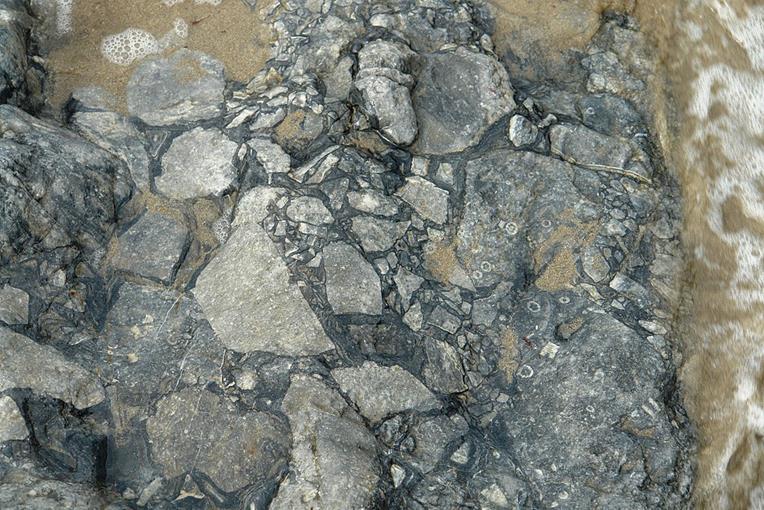
Breccia will have colors of their constituent rock fragment and cementing matrix. Some of their uses are in architectural elements, making sculptures, gems, etc.
6. Conglomerates
Conglomerates are clastic sedimentary rocks with large (<2mm) rounded rock fragments or minerals cemented in a fine grain matrix. They are like breccias except for the rounded and not angular large rock or mineral pieces.

7. Chert
Chert is a fine-grained sedimentary rock of silicon dioxide or quartz either in microcrystalline (particles visible only in a microscope) or cryptocrystalline (a fine structure with no distinct particles seen on a microscope) form. It is mainly an organic sedimentary rock formed from marine plankton’s siliceous skeletons. However, it may also form chemically by the precipitation of quartz.
Chert is often white, black, cream, or brown. However, it may be yellow, red, or orange with other colors, meaning it has organic matter and mineral impurities.

There are a variety of chert rocks. Examples are jasper (often reddish), chalcedony (quart and moganite intergrowth and onyx (banded chalcedony). Others are agate, porcelanite, novaculite, etc.
Since it is hard and has a conchoidal fracture that leaves sharp edges, chert was used to make tools in ancient times. However, today, it has a few uses. Some of these uses include road surfacing, driveway construction, and making quartz sand.
8. Flint
Flint is a variety of chert with cryptocrystalline quartz that occurs in either marly limestone or chalk. This hard and touch rock forms chemically or biologically. Also, it shows conchoidal fracture. You will find it as a nodule in chalk rock or marine limestone.
Flint comes in many colors. Some common ones are brown, gray, black, reddish-brown, off-white, etc. Remember, the various impurities present influence color.

In ancient times, flint helped to start a fire and make weapons. Now, it has uses in construction and is a gem. However, they are not many.
9. Coal
Coal is black or brownish-black organic sedimentary rock with at least 50% organic matter by weight. This combustible rock forms when plant remains accumulate and are carbonized in wetlands or swampy areas. This process takes millions of years.
On rank or type, anthracite is the best coal. However, it is a metamorphic and not sedimentary rock like other coal ranks. It is followed by bituminous, sub-bituminous, and lignite.

As you may know, coal is the most important fossil fuel used to generate electricity, steel making (coke) energy to produce cement. Also, it has uses in the paper, textile, glass, synthetic rubber, paint, solvent, plastics, synthetic fiber, etc.
10. Porcellanite or porcelanite
Porcellanite is a hard, dense, highly siliceous (high in silica) sedimentary rock that looks like unglazed porcelain, hence the name. It is an impure chert that contains clay and calcareous matter with a conchoidal fracture and occurs in a bedded form.
Porcellanite has a dull luster with colors ranging from dark gray to black to white. However, yellow, green, and other colors.
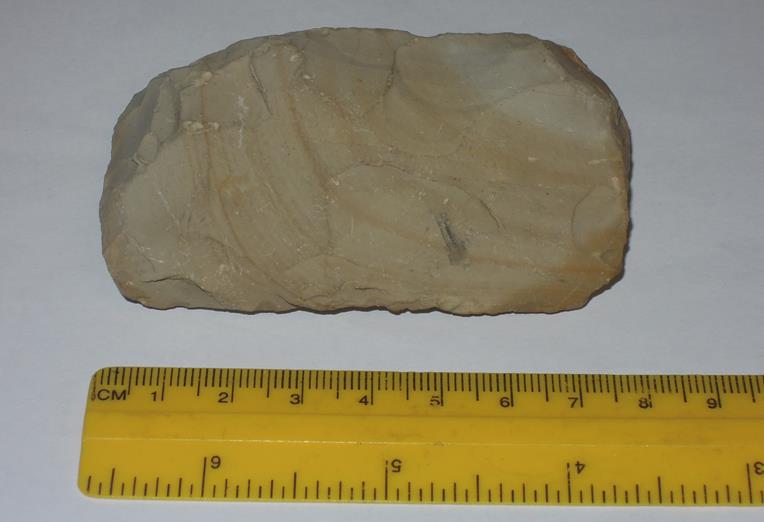
Some key uses of porcelanite are in construction and filling shorelines, especially at Darwin.
11. Phosphorite (phosphate rock)
Phosphorite is a non-clastic sedimentary rock rich in minerals that bear phosphate. Its phosphate content is at least 15-20% but may be as little as 4%.
Some phosphate sources are marine invertebrate shells or vertebrate bone and excrement. Also, it may be from chemically dissolved phosphate from igneous and metamorphic rocks.
Phosphate rocks are dark brown to black and form laminate beds (a few inches to several meters thick). But depending on the constituents, they can be green, red, violet, white, or yellowish.

Uses of phosphate rocks include making fertilizers, supplementing animal feed, and making elemental phosphorus. Also, it has usages in food preservatives, baking flour, detergents, and insecticides. Others are water treatment, ceramics, cosmetics, pharmaceuticals, metallurgy, etc.
12. Caliche
Caliche is a hard sedimentary rock formed when calcium carbonate cements sand, clay, gravel, or silt. However, the cementing agent may sometimes be gypsum, iron oxide, silica, and magnesium. These rocks are common in aridisol and mollisol in arid or semi-arid areas worldwide.
Caliche is often light-colored. However, it may be white, pale pinkish, gray, or reddish-brown, among other colors.

Lastly, some of the uses of caliche include construction (making mortar, aggregate, or walls), Portland cement manufacture, and may have other valuable minerals. However, they are a nuisance to agriculture, i.e., prevent drainage, alter root development, etc.
13. Mudrocks or lutites
Mudrock refers to fine-grained, siliciclastic sedimentary rocks with grains less than 1⁄16 mm or 0.00246 inches. Siliciclastic has mainly silicate minerals like quartz, feldspar, and clay minerals. Also, they may have calcite, siderite, dolomite, marcasite, pyrite, heavy minerals, or organic compounds. However, their particles are less than 63 micrometers.
Also, mudrock should have at least 50% silt (1/16 – 1/256mm) and clay-sized (less than 1/256 millimeter) particles. This mixture is known as mud.

Examples of mudrock include claystone, shale, siltstone, and slate. Also mudstones are another example.
14. Claystone
Claystone is a clastic sedimentary rock with at least 50% clay or phyllosilicates with grains 1/256mm or less. Examples of phyllosilicates are serpentine, clay minerals (kaolinite, talc, vermiculite, chlorite), and mica.
Claystone has the finest grains among mudrocks with less than ⅓ silt and comes in various colors, i.e., black, brown, green, gray, orange, white, yellow, blue, etc. The exact color depends on the present minerals and impurities.

Some of the uses of claystone include raw materials for making cement, mortar, and aggregate for road building. Also, it has an application sintering agent in iron ore processing in steel industries. More uses in roofing tiles, facing stones (claystone bricks), floor tiles, sculptures, pottery, etc.
15. Mudstone (calcilutite)
Mudstone is a fine-grained siliciclastic sedimentary rock that is not fissile or laminate, i.e., does not split along parallel layers. It is one of the mudrocks with predominantly silt (⅓-2/3 of the particles), and clay-sized particles and siliciclastic minerals should account for more than 50%.
Mudstones are available in various colors like black, gray, white, brown, red, green, blue, orange, yellow, etc.

Some of the uses of mudstones are entryway, facing, landscaping, retaining and exterior boundaries stones, and pavers. Also, they make roofing and flooring tiles, cement, construction aggregate (hard ones), etc. More uses include pottery, sculptures, pavers,
16. Siltstones (aleurolite or calcisiltite)
Siltstone is a lithified, non-laminated (cleavage) fine grain clastic sedimentary rock. This mudrock has more than 50% silt-sized particles, i.e., smaller than sand but larger than clay, i.e., 1/16- 1/256mm, and is low clay content.
Siltstone comes in many colors, especially grays, browns, and reddish brown. However, you can find green, white, purple, red, black, orange, or yellow ones.

Lastly, siltstone doesn’t have many uses except for use as a low-quality landfill when there are no other options. People rarely mine it for construction, and it can’t serve as a good aquifer (too small pores). Also, it isn’t porous enough to be a gas or oil reservoir.
17. Shale
Shale is fine-grained, fissile (laminate) clastic sedimentary rock with feldspar silt, clay minerals, and quartz. It comprises mud, i.e., clay and silt-sized (more than ⅔) particle size, making it gritty, and at least 50% of particles measure less than 0.062 mm. Also, it splits alone thin layers (less than a centimeter).
Shale color depends on its constituents. It is mostly dark gray to black. However, you will find red, brown, green, purple, blue, black, and other colors.

Lastly, shale is the most abundant sedimentary rock whose uses include making bricks, tiles, and Portland cement. Other uses are pottery and fossil fuel if it has hydrocarbon organic matter like oil shale.
18. Oil shale
Oil shale is a fine-grained, oil-rich sedimentary rock that contains kerogen, an insoluble solid organic matter. Besides kerogen, other key constituents include calcite, quartz, clay, feldspar, and pyrite. Also, it may have some bitumen (asphalt) and other trace minerals like iron, uranium, vanadium, nickel, titanium, silver, manganese, barium, boron, zinc, etc.
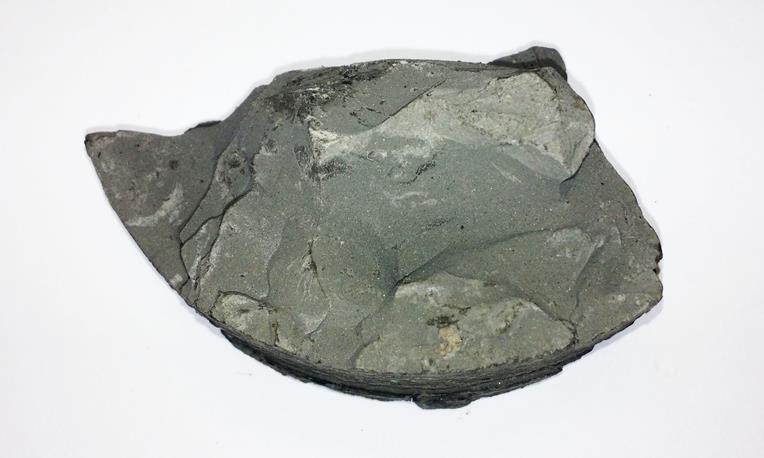
Oil shale is brown to black and uses include fossil fuel, especially as a marine and heating fuel. Also, it has applications in making chemicals.
19. Diamictite
Diamictite lithified clastic sedimentary rock with non-sorted or poorly sorted varied-sized particles, i.e., from clay-sized to boulders embedded in sandstone or mudstone matrix. However, if they are non-lithified, they are known as diamicton.
Diamictite color varies from gray, black, brown, buff, etc. However, the exact color will depend on the constituent rock.

Uses of diamictite are construction (building or dimensional stones and aggregate), paving, curbing, and landscaping. Indoors, you can use them as decorative aggregate.
20. Limestone
Limestone is a sedimentary carbonate rock mainly made of more than 50% calcium carbonate. The calcium carbonate is primarily in calcite and aragonite forms.
Limestone may be biologically formed marine organisms that remain chemically via precipitation of calcium in the water. It has microscopic to visible grains size and is white or nearly white in its pure form.
However, impurities like sand, manganese, iron oxide, organic remains, etc., may result in other colors like gray, red, yellow, off-white, etc.

Limestone has many uses like dimensional stones, pavers, ballast, aggregate, cement manufacture, sculptures, etc. It is also the main source of lime and is an additive in paints, plastics, toothpaste, tiles, fertilizers, etc.
Many limestone forms exist, including tufa, fossiliferous, lithographic, micrite, oolitic, travertine, chalk, macrocrystalline, coquina, etc. We will cover a few of these types as we discuss examples of sedimentary rocks.
21. Chalk
Chalk form of limestone notable by its white or light color, softness, and high porosity. It is a biogenic (biological) kind of sedimentary rock from skeletal remains of planktons in oceans.

This rock with minute marine calcite shells has many uses, including writing, making blackboards, or polishing chalk. Also, it works as an extender, pigment, or filler in many materials like ceramics, plastics, rubber, paints, linoleum, paper, crayons, cosmetics, putty, etc.
22. Coquina
Coquina is a tan biological kind of limestone rock with calcite and particles at least 2mm in size. It is composed of whole or fragments of various shells and invertebrates. Some of these invertebrates are mollusks, foraminifera, brachiopods, and trilobites.
This sedimentary rock is relatively soft and poorly to moderately cemented. However, the unconsolidated coquinas are known as grainstones.

Some present-day uses of coquina are making fertilizer (since it has phosphate) and sculptures. Also, it once was used in construction and paving.
23. Travertine
Travertine is another limestone kind with mainly calcite and aragonite. It forms is quick precipitation of calcium carbonate from rivers, mineral springs, or hot springs. So, it is a chemically formed terrestrial sedimentary rock.
Travertine is white, pale cream to soft ivory. However, iron, sulfur, and other impurities may make it yellowish, brown, tan, pink, reddish, rusty, etc.

Uses of travertine include wall cladding, decorating ceiling, façade material, flooring and paving patio, driveways, pool decks, or walkways.
24. Tufa rock
Tufa is a kind of limestone rock closely related to travertine. It is formed by the precipitation of calcium carbonate at ambient and not high temperatures like travertine. However, it is more porous.

Tufa comes in various colors, i.e., white, light gray, cream, or tan, and uses include making planters for alpine gardening (alpine rockeries), fountains, and some pond or garden features. Also, it makes hypertufa, a concrete mixture for making alpine planters.
25. Dolostone (dolomite) rock
Dolostone is a chemical sedimentary rock high in rock-forming mineral dolomite. Dolomite is calcium and magnesium carbonate or CaMg(CO3)2. It is one of the sedimentary carbonate rocks, the other being limestone.
Dolomite has fine to coarse grains that occur in massive beds. Its color is shades of gray. However, it may be white, yellow, tan, pink, purple, reddish-brown, yellow-brown, or black, depending on the present impurities.

Some of the dolostone uses are limestone. They include a dimensional stone, making construction aggregate, neutralizing soil acidity, fillers in fertilizer, making magnesium chemicals like Epsom salt, glass manufacture, etc. However, dolostone may be preferred since it’s harder than limestones, has lower solubility, and resists acid more.
26. Gypsum rock
Gypsum is a soft hydrous calcium sulfate chemical sedimentary rock with a pearly, silky, dull, or vitreous luster formed by evaporation of water (sea or ocean) high in calcium and sulfate.
This rock is clear (transparent), colorless, mottled white, or grayish. However, due to impurities, it can be tinged yellow, blue, green, tan, pink, dark brown, or reddish-brown.
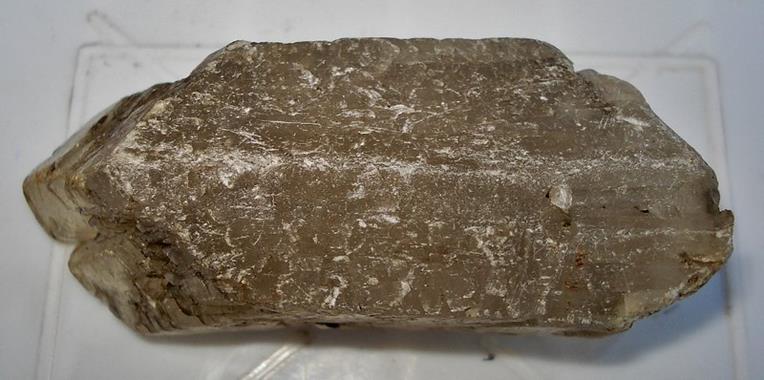
This rock occurs as Massive, flat, elongated, or prismatic crystals, with common varieties being alabaster, selenite, satin spar, and fibrous.
Lastly, gypsum has many uses, including making drywall, blocks, boards, and retarding Portland cement hardening. Other applications include agriculture, culinary, sidewalk chalk, medicinal filler, and plaster of Paris.
27. Bauxite
Bauxite is an aluminum-rich (15-25%) clastic sedimentary rock with a pisolitic structure. It is formed via weathering of surface rocks, especially clay rocks. Some involved rocks are granites, basalts, clays, shales, gneisses, syenite, clay-rich sandstones, dolerite, gabbros, etc.
Bauxite comprises chiefly aluminum hydroxide minerals and mixtures of silica, titania, iron oxide, aluminosilicate, etc. It is a soft (some are hard), dull, white to grayish rock. However, it may be tan, reddish-brown, yellowish, pinkish, or brown color due to the presence of iron and other impurities.

What are its main uses? Bauxite is the main source of aluminum and gallium. Also, it has many applications in the petrol, refractory, cement, steel, and chemical industries.
28. Ironstones or iron formations
Ironstones or iron formations are sedimentary rocks that contain at least 15% iron. Iron is present in various iron-bearing minerals, i.e., oxides, carbonates, silicates, or a combination. Examples are limonite, hematite, magnetite, siderite, or chamosite.
Ironstones result from ferruginous sediment (clastic) or chemical precipitate or replacement. They may be hard, calcareous, non-banded, coarsely banded but non-cherty. Also, they may have quartz grains, pebbles, ooliths, or macrofossils.

Ironstones are purple-grey or brown but will turn orange-brown or yellow-brown when oxidized. Some of their uses are ceramic (Ironstone China), construction, and landscaping stones.
29. Banded iron formation (BIFs)
These are ironstones (with iron <15%) with alternating layers of iron oxide (but may have iron carbonate) and shale, jasper, or cherts that are poor in iron. The layers are from a few millimeters to a few centimeters. Those with iron oxide will be dark gray to black, while those with low-iron shale, jasper, or chert will be red, yellow, or cream.
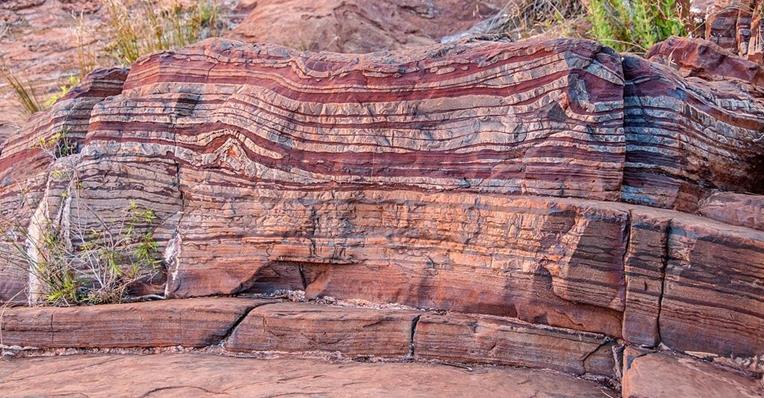
These sedimentary rocks reveal that the atmosphere was once without oxygen. Also, they are an important source of iron ore, and many have gold deposits.
30. Halite
Halite or rock salt is a mineral form of sodium chloride (NaCl). It is one of the evaporate deposits (chemically formed rocks) with a colorless to white color. However, it may be blue, pink, red, purple, yellow, orange, or gray, depending on impurities like a present and isotopic or structural abnormality.

Some of the uses of halite are deicing roads, driveways, or walkways and as a water softener. Also, it can kill weeds by dehydration, and you can add to the ice in your color to a low melting point. This will ensure the ice doesn’t melt easily.
Lastly, don’t confuse rock with sea salt; you shouldn’t use it for culinary purposes or making brine unless labeled food grade.
Sedimentary rocks by grain size
Besides the above types of sedimentary rocks and examples, you can also classify these rocks in terms of grain sizes. Here are the main categories:
| Sedimentary rock type | Grain size | Examples |
| Coarse-grained | >2 mm | Conglomerates, breccia |
| Medium grained | 1/16 mm to 2 mm | Sandstones |
| Fine-grained | <1/16 mm | Siltstone, claystone, mudstone, and shale |
Sedimentary rocks by the composition
The last way to look at sedimentary rocks is by considering their composition. Using this criterion, you will have the following classes:
| Sedimentary rock type | Main composition | Example |
| Siliciclastic | Silicates (salts of silica) | Breccias, conglomerates, mudrocks, and sandstone |
| Carbonate | Calcite, dolomite, and aragonite | Dolomite and limestone |
| Evaporite | Carbonates, chlorides, sulfates | Gypsum, anhydrite, and halite |
| Organic rich | Have more than 3% total carbon content | Shale, coal, and source rocks |
| Siliceous | Silica (quart) or silicon dioxide | Opal, chert, and chalcedony |
| Iron-rich | 15% or higher iron content | Banded iron and iron stones |
| Phosphatic | Have more than 6% phosphorus | phosphate nodules, phosphatic mudrocks, and bone beds |


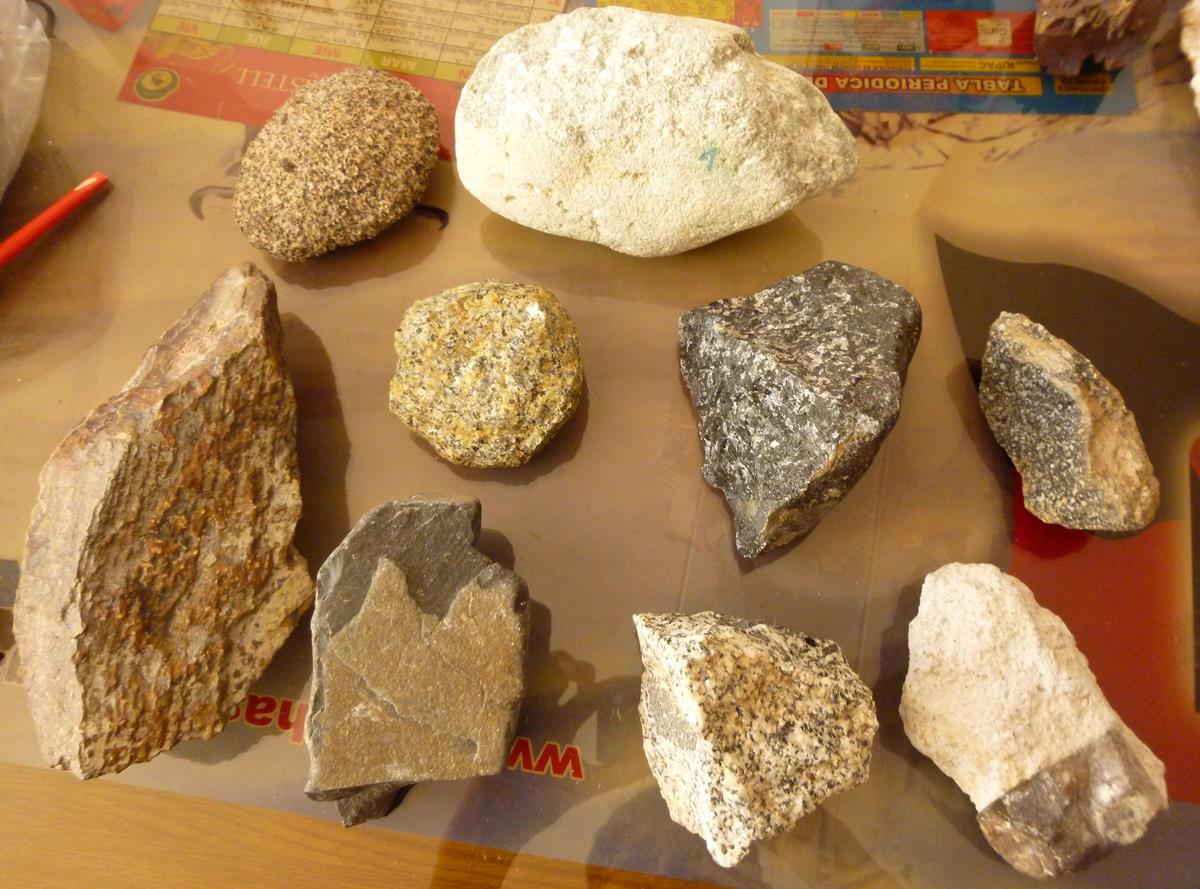
Leave a Reply